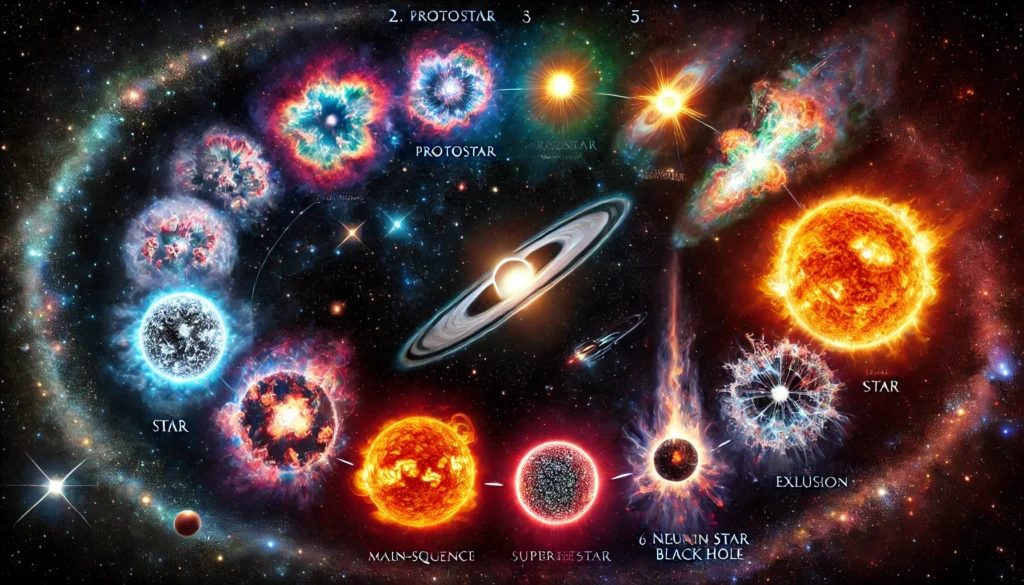Greetings, cosmic explorers! Captain Nova here, reporting from the Odyssey Explorer on Day 22 of our “100 Days of Space Exploration” journey. Yesterday, we explored the formation of stars, but today, we follow their entire life cycle—from their fiery birth to their ultimate fate. Stars are the engines of the universe, shaping galaxies and creating the elements that make up everything around us. Let’s embark on this stellar journey!

Stage 1: The Birth of a Star
Stars are born within giant molecular clouds, vast regions of gas and dust that stretch across space. These clouds remain stable until an external force—such as a supernova explosion, collision of galaxies, or gravitational turbulence—triggers the collapse of a dense region. Gravity pulls the gas inward, forming a protostar, a young, glowing mass of gas that continues to contract and heat up.
During this process, the core temperature rises, and if the protostar gathers enough mass, nuclear fusion ignites, converting hydrogen into helium. This marks the birth of a fully developed star. The outward radiation pressure from fusion balances the inward pull of gravity, allowing the star to stabilize in what is known as the main sequence phase.
Stage 2: The Main Sequence – The Star’s Prime
A star spends most of its life in the main sequence phase, where hydrogen fusion in the core powers the star. The duration of this phase depends on the star’s mass:
- Small stars (Red Dwarfs): These cool, dim stars burn fuel slowly and can last trillions of years.
- Medium stars (like our Sun): These shine steadily for about 10 billion years.
- Massive stars: These blue giants burn fuel rapidly, lasting only a few million years.
As the star shines, energy and radiation are released, making life possible on surrounding planets if they exist within the star’s habitable zone. Our Sun is currently halfway through its main sequence life, with about 5 billion years remaining before it enters its next phase.
Stage 3: Leaving the Main Sequence – The Expansion
When a star exhausts its hydrogen fuel, fusion slows, and gravity causes the core to contract. This generates intense heat, triggering the fusion of helium into heavier elements such as carbon and oxygen. As a result, the outer layers expand, and the star transforms into a red giant (for medium stars) or a red supergiant (for massive stars).
For stars like the Sun, this phase lasts a few million years. As it expands, the Sun will likely engulf Mercury, Venus, and possibly Earth! This swollen state is short-lived, lasting only a fraction of the star’s total lifespan.
Massive stars, on the other hand, continue fusing elements beyond helium, creating heavier elements up to iron. The buildup of iron in the core signals the impending collapse of the star.
Stage 4: The Final Stages – How Stars Die
A star’s fate depends on its mass. Let’s explore the possible endings:
Low-Mass and Sun-Like Stars (White Dwarfs)
Once helium fusion ceases, the outer layers drift into space, forming a beautiful planetary nebula. The remaining core, now a white dwarf, is an Earth-sized but incredibly dense remnant that will cool over billions of years, eventually becoming a black dwarf (a cold, dark stellar remnant). White dwarfs no longer generate energy but remain incredibly hot for billions of years before cooling completely.
Massive Stars (Supernovae, Neutron Stars, and Black Holes)
For massive stars, the collapse continues beyond the red supergiant phase. When fusion stops, gravity causes the core to collapse violently, triggering a supernova explosion—one of the most powerful events in the universe. The supernova disperses heavy elements into space, seeding the cosmos with the building blocks of future stars and planets.
Depending on its remaining mass, the core becomes:
- A Neutron Star (if between 1.4 and 3 times the Sun’s mass): A dense core made mostly of neutrons, spinning rapidly and emitting intense radiation as a pulsar. Neutron stars are only about 10-15 kilometers wide but contain more mass than the Sun!
- A Black Hole (if more than 3 times the Sun’s mass): An object so dense that not even light can escape its gravity. Black holes warp space and time, forming one of the most mysterious objects in the universe.
The Cosmic Recycling System
The elements released in supernovae scatter into space, enriching molecular clouds with heavier elements like carbon, oxygen, and iron. These materials become part of new stars, planets, and even life itself. In essence, every atom in our bodies was once part of a star—truly making us “star stuff.”
Stars are not just cosmic beacons; they are the universe’s factories, forging the elements that make up everything we see. Without stars and their eventual deaths, planets, moons, and even life itself could not exist.
The Future of Our Sun
As a medium-sized star, the Sun will one day exhaust its hydrogen fuel and expand into a red giant. Scientists predict this will happen in about 5 billion years. It will then shed its outer layers, creating a stunning planetary nebula, leaving behind a white dwarf. Earth and the other inner planets will likely be uninhabitable long before that, as the Sun’s increasing luminosity gradually evaporates the oceans and strips away the atmosphere.
While this may sound ominous, the good news is that humanity has plenty of time to explore the stars and even seek new homes among them!
Looking Ahead
Tomorrow, we’ll dive into the Types of Stars in the Universe, exploring the dazzling diversity of stars, from red dwarfs to hypergiants. Each type of star tells a different story about the cosmos and its evolution.
Until then, keep looking up and wondering!
Captain Nova
Odyssey Explorer
Leave a Reply